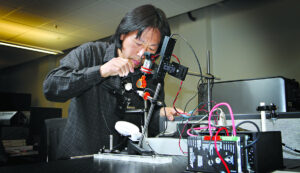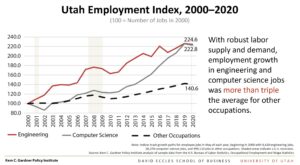 In 2020, Utah’s engineering and computer science workforce generated 238,400 full- and part time jobs, $19.1 billion in earnings, and $25.2 billion in gross domestic product (GDP), representing 12% to 15% of Utah’s $200 billion economy. This is according to the latest report from the Kem C. Gardner Policy Institute, which details how in every major industry, and in communities statewide, engineering and computer science professionals contribute to meaningful innovation, research, and entrepreneurship.
In 2020, Utah’s engineering and computer science workforce generated 238,400 full- and part time jobs, $19.1 billion in earnings, and $25.2 billion in gross domestic product (GDP), representing 12% to 15% of Utah’s $200 billion economy. This is according to the latest report from the Kem C. Gardner Policy Institute, which details how in every major industry, and in communities statewide, engineering and computer science professionals contribute to meaningful innovation, research, and entrepreneurship.
“The emphasis placed on engineering and computer science education by state leaders in the early 2000’s has created enormous benefits for the Utah economy,” said Levi Pace, Senior Research Economist at the Gardner Institute, and lead author of the report. “Engineers, tech workers, and professionals in related occupations are taking increasingly active roles in the economy and society. In addition to these broader economic and societal benefits, the data show favorable returns on education investments in terms of personal income, both short- and long-term.”
The report also details student outcomes and research activity in engineering and computer science programs in Utah’s colleges and universities, which receive significant funding for their research. In fiscal year 2021, the University of Utah, Utah State University, and Brigham Young University together accounted for $175.7 million of the $183.0 million of engineering and computer science research awards to the eight universities and colleges. The state’s flagship, the University of Utah, received grants and contracts worth $105.0 million for engineering and $26.5 million for computer science, approximately three fourths of the total research funding.
“Thanks in large measure to the vision of former Gov. Michael Leavitt in establishing the Engineering Initiative, and the continued support of the Utah Legislature, our state’s public universities have significantly grown the number of graduates in computer science and engineering,” explains U of U College of Engineering Dean Richard Brown. “These graduates are the workforce and many of the founders of Utah’s high-tech companies.”

University of Utah President Taylor Randall also commented: “Engineering and computer science jobs are at the center of the great innovations that are driving the Utah economy. As the state’s flagship research university, the U’s contribution to that workforce is vital in solving the issues we face as a society. Our renewed commitments in research, science, and technology will continue to serve these exemplary students as they become the innovators of tomorrow.”
Key findings from report include the following:
State Comparison – Since 2000, growth in Utah engineering employment outpaced growth in U.S. engineering employment by more than fivefold. The state’s computer science employment over this same period outpaced the nation by more than double.
Student Degree Completions – The number of new engineering and computer science graduates increased from 1,540 in 2000 to over 3,700 in 2020. These engineers and computer scientists support Utah’s dynamic tech sector, also commonly referred to as “Silicon Slopes.”
Wages – Utahns with engineering jobs made an average of $96,600 in wages in 2020, and computer science workers earned $89,500—80% and 66% higher than the $53,800 state average, respectively.
Experience – Compared with their wages one year after degree completion, engineering and computer science graduates employed in Utah earn 31% more after four years and 59% more after eight years.
Higher Education Graduates in the Workforce – Even after adjusting for inflation, engineering and computer science graduates earned 31% more four years post-graduation than their first-year wages. Wages increased 59% from the first year to eight years post-graduation.
University of Utah – In 2020, the University of Utah had the highest number of engineering degrees in the state at 805 completions, representing 41% of the USHE total. Utah State followed with 497 (25%). The U also had the highest share of USHE computer science completions (571, 32%), followed by Utah Valley University (369, 21%).
The full report is now available online.